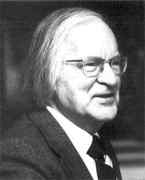Person: Rohrbach, Hans

Hans Rohrbach was a German mathematician who worked in algebra and number theory. He later worked as cryptanalyst.
Mathematical Profile (Excerpt):
- He himself always used the name Hans Rohrbach but one source gives his full name as Hans Joachim Albert Rohrbach while Bernhard Neumann said that he believed his full name was Hans Wolfgang Rohrbach and he was certain his middle initial was W.
- Amid this confusion we have decided to simply give his name as Hans Rohrbach.
- Paul Rohrbach, whose full name was Karl Albert Paul Rohrbach, was born on 29 June 1869.
- Hans entered the Gymnasium of Berlin-Friedenau in the autumn of 1909 and continued his education there until the autumn of 1917.
- After leaving the Gymnasium of Berlin-Friedenau in the autumn of 1917, Hans entered the Fichte Gymnasium in Berlin-Wilmersdorf.
- Later, Rohrbach was taught by some outstanding mathematicians including Erhard Schmidt, Issai Schur, and Ludwig Bieberbach.
- Rohrbach was, at this time, head of the Berlin student organisation Mathematisch-Physikalische Arbeitsgemeinscaft.
- Rohrbach called his visit a "propaganda trip" and he travelled round American Universities trying to collect money for Berlin students.
- In the autumn of 1924, Rohrbach took up his studies again at the University of Berlin and was enrolled there until 1929.
- During his studies at Berlin, Rohrbach attended lectures, exercise classes and seminars by many leading mathematicians whom he names in his doctoral thesis as: Ludwig Bieberbach, Eugen Blasius, Max Dessoir, Georg Feigl, Heinz Hopf, Wolfgang Köhler, Max von Laue, Karl Löwner, Richard von Mises, Max Planck, Hans Rademacher, Heinrich Rubens, Wilhelm Schlenk, Erhard Schmidt, Issai Schur, Gabor Szegő, Arthur Wehnelt, and Wilhelm Westphal.
- While studying at the University of Berlin, Rohrbach had met a student Rose Gadebusch (born 1905) who began her studies of mathematics in 1925.
- Like Rohrbach, Rose Gadebusch took a major role in the Mathematisch-Physikalische Arbeitsgemeinscaft while she was a student.
- In 1936 Rohrbach was appointed as a senior assistant at the University of Göttingen.
- Let us now describe a puzzle that Rohrbach introduced in 1937 that has been the source of much interest and research ever since.
- In the 1937 paper just quoted, Rohrbach finds asymptotic bounds for nnn with hhh fixed and kkk large.
- Many mathematicians have looked at this problem, Rohrbach's bounds have been improved but, in general, the problem is far from being solved.
- The war work that Rohrbach undertook in the Mathematical Institute was related to computational problems associated with the manufacture of V-weapons at Peenemünde.
- Rohrbach set up a work group of young girls who were in their final years at a Gymnasium and trained them to carry out mathematical and statistical computations.
- We will discuss Rohrbach's "missionary concerns" towards the end of this article.
- One of the men that Rohrbach "rescued" with his computing group was Ernst Mohr, and later it was Rohrbach's skilful diplomacy that saved Mohr after he had been sentenced to death by the Peoples' Court on 24 October 1944.
- Rohrbach's assistants Franz Krammer and Paul Armsen were also "rescued" by Rohrbach.
- Armsen was appointed by Rohrbach first as his assistant, later as a special lecturer.
- Rohrbach, however, had another role in Germany's war effort, namely working at a cryptologist for the Foreign Office in Berlin.
- In the October 1944 report from which we quoted above, Rohrbach explains that he cannot give his full attention to the Mathematical Institute of the German University of Prague because of his commitments in Berlin.
- After the war ended, in 1948 Rohrbach published a paper in two parts entitled Mathematische und Maschinelle Methoden bei Chiffrieren und Deschiffrieren Ⓣ(Mathematical and automated methods in encryption and decryption).
- Rohrbach recommended including vulnerability to errors when assessing the security of a method, on the principle that humans err.
- He developed what is today called Rohrbach's Maxim: In judging the encryption security of a class of methods, cryptographic faults and other infringements of security discipline are to be taken into account.
- The U.S. cryptologists could not imagine that Rohrbach had broken their M-138-A strip cipher which he did in 1943 after working on it for a year.
- Rohrbach led a team of mathematicians who used IBM/Hollerith punch card equipment and also built their own special decoding device which they called 'Automaton'.
- The file also states that Ernst Mohr was assigned to be Rohrbach's replacement in Prague during his activities in the Foreign Office in Berlin.
- After the war ended, Rohrbach was not allowed to teach for a number of years.
- Finally, let us return to Rohrbach's "missionary concerns" which we mentioned above.
- Rohrbach was the first president of Studentenmission in Deutschland, an organisation which aimed to spread Christian values in German schools and universities.
Born 27 February 1903, Berlin, Germany. Died 19 December 1993, Bischofsheim an der Rhon, Germany.
View full biography at MacTutor
Tags relevant for this person:
Origin Germany
Thank you to the contributors under CC BY-SA 4.0! 

- Github:
-

- non-Github:
- @J-J-O'Connor
- @E-F-Robertson
References
Adapted from other CC BY-SA 4.0 Sources:
- O’Connor, John J; Robertson, Edmund F: MacTutor History of Mathematics Archive
